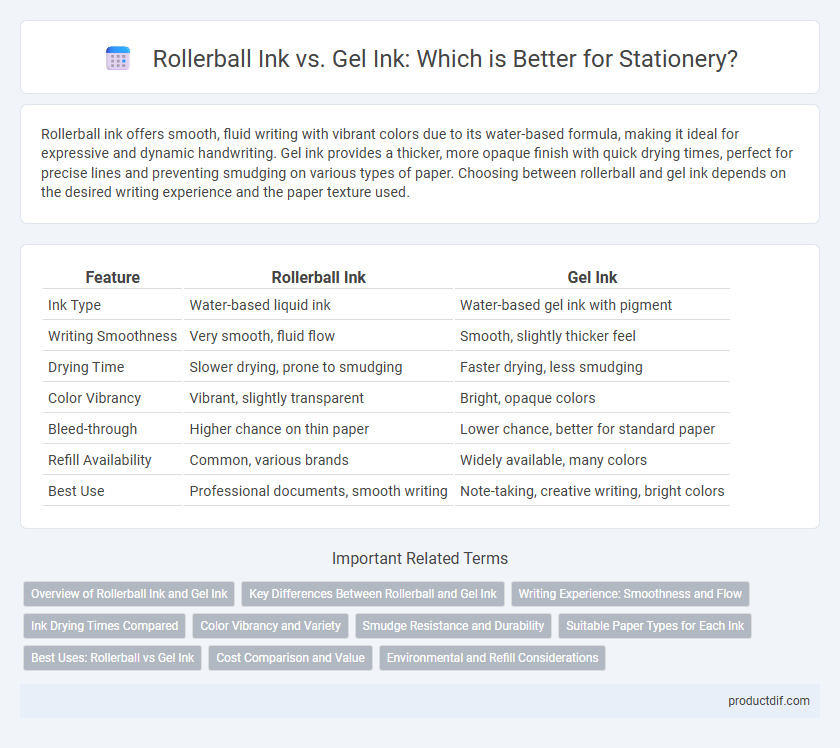Rollerball ink offers smooth, fluid writing with vibrant colors due to its water-based formula, making it ideal for expressive and dynamic handwriting. Gel ink provides a thicker, more opaque finish with quick drying times, perfect for precise lines and preventing smudging on various types of paper. Choosing between rollerball and gel ink depends on the desired writing experience and the paper texture used.
Table of Comparison
| Feature | Rollerball Ink | Gel Ink |
|---|---|---|
| Ink Type | Water-based liquid ink | Water-based gel ink with pigment |
| Writing Smoothness | Very smooth, fluid flow | Smooth, slightly thicker feel |
| Drying Time | Slower drying, prone to smudging | Faster drying, less smudging |
| Color Vibrancy | Vibrant, slightly transparent | Bright, opaque colors |
| Bleed-through | Higher chance on thin paper | Lower chance, better for standard paper |
| Refill Availability | Common, various brands | Widely available, many colors |
| Best Use | Professional documents, smooth writing | Note-taking, creative writing, bright colors |
Overview of Rollerball Ink and Gel Ink
Rollerball ink uses a water-based formula that delivers smooth, fluid lines similar to fountain pens, offering vibrant color and quick drying time. Gel ink combines pigment with a water-based gel, providing bold, vivid colors with a smooth writing experience and enhanced resistance to smudging. Both inks excel in precision and clarity, with rollerball ink favoring a more liquid flow and gel ink emphasizing thicker consistency and longer-lasting vibrancy.
Key Differences Between Rollerball and Gel Ink
Rollerball ink uses water-based liquid ink that provides smooth, fluid writing with vibrant colors and less pressure, while gel ink contains pigment suspended in a water-based gel, offering bolder lines and quick-drying properties. Rollerball pens typically deliver more consistent ink flow and a thinner line, ideal for detailed work, whereas gel pens provide thicker, more opaque strokes suitable for vivid, long-lasting marks. The key differences lie in drying time, ink viscosity, and writing feel, with rollerball favoring smoothness and gel emphasizing color intensity and durability.
Writing Experience: Smoothness and Flow
Rollerball ink offers a smoother writing experience due to its water-based formula, providing fluid and consistent ink flow that mimics the feel of a fountain pen. Gel ink, while also smooth, tends to have a thicker consistency, resulting in a slightly more controlled flow that reduces bleeding and smudging on paper. Both inks deliver vibrant colors, but rollerball ink excels in effortless glide, ideal for prolonged writing sessions.
Ink Drying Times Compared
Rollerball ink typically dries faster than gel ink due to its water-based formula, which absorbs quickly into paper fibers, reducing smudging and making it ideal for fast note-taking. Gel ink, while offering vibrant colors and smooth writing, tends to have longer drying times because of its thicker, pigment-based composition, which sits on the paper surface before setting. Choosing between rollerball and gel ink depends on the need for quick drying versus vivid, bold lines in stationery use.
Color Vibrancy and Variety
Rollerball ink exhibits higher color vibrancy due to its liquid ink formula, producing rich and intense hues ideal for dynamic writing and artistic expression. Gel ink offers a wide variety of vibrant colors with smooth application and quick drying times, making it popular for both everyday writing and creative projects. The choice between rollerball and gel ink depends on whether one prioritizes saturated color depth or a broader palette with consistent flow.
Smudge Resistance and Durability
Rollerball ink offers a smooth writing experience but tends to have lower smudge resistance compared to gel ink, making it prone to smearing on glossy or non-porous surfaces. Gel ink, known for its high viscosity and quick-drying formula, provides superior smudge resistance and long-lasting durability, ideal for documents requiring clarity and permanence. Both inks excel in different stationery applications, with gel ink preferred for smudge-free, durable writing and rollerball ink favored for fluid, expressive strokes.
Suitable Paper Types for Each Ink
Rollerball ink performs best on smooth, absorbent paper such as high-quality writing or fountain pen paper, where its liquid-based composition flows evenly without feathering. Gel ink is ideal for coated or glossy paper varieties, including photo paper or card stock, as its thicker consistency adheres well and dries quickly without smudging. Choosing the appropriate paper enhances ink clarity, durability, and overall writing experience for both rollerball and gel inks.
Best Uses: Rollerball vs Gel Ink
Rollerball ink offers smooth, fluid lines ideal for detailed writing and expressive signatures, making it perfect for professional documents and note-taking. Gel ink provides vibrant, quick-drying colors well-suited for everyday use, color-coding, and creative projects. Both inks excel in different scenarios based on drying time and writing texture, with rollerball favored for precision and gel ink preferred for versatility.
Cost Comparison and Value
Rollerball ink typically costs more upfront due to its liquid formulation and smooth writing experience, while gel ink pens offer a more budget-friendly option with vibrant color payoff and consistent flow. The value of rollerball pens lies in their premium feel and professional appearance, making them ideal for important documents despite higher refill prices. Gel ink pens balance cost efficiency with quality, providing longevity and less frequent replacements, making them a practical choice for everyday use and bulk purchasing.
Environmental and Refill Considerations
Rollerball ink typically uses water-based formulas that are easier to refill and generate less plastic waste compared to gel ink cartridges, which often require complete replacement due to their thicker consistency. Gel ink pens tend to have shorter lifespans and less eco-friendly disposal options, as their refills are less commonly available and involve more plastic components. Choosing rollerball pens with refillable cartridges supports sustainability efforts by reducing single-use plastics and minimizing environmental impact.
Rollerball ink vs Gel ink Infographic

 productdif.com
productdif.com